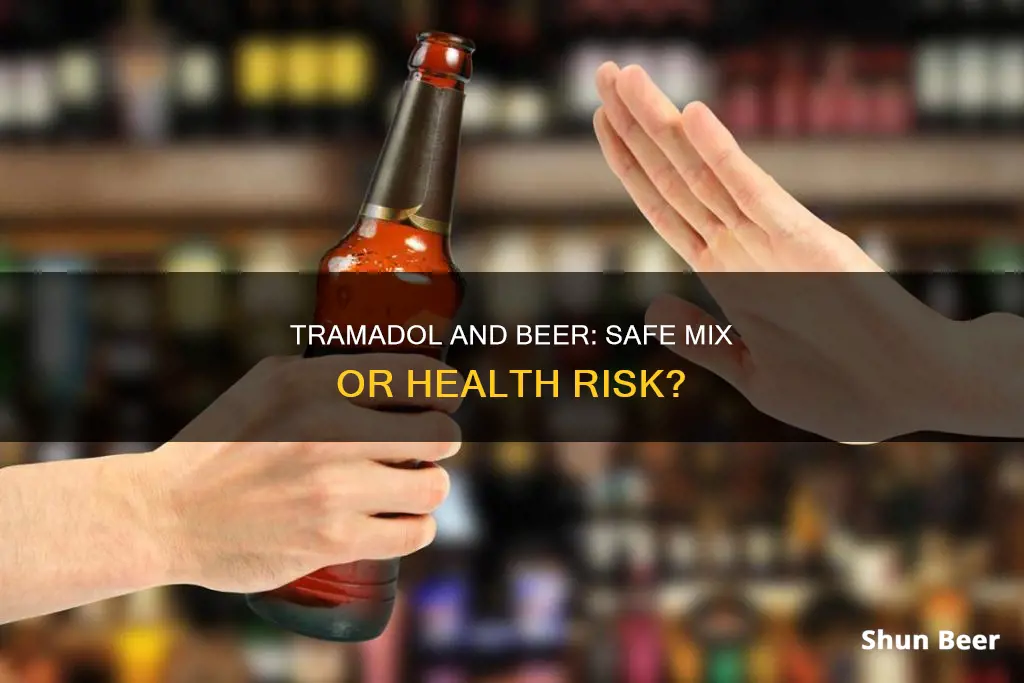
Drinking alcohol after taking tramadol is not recommended. Both substances are central nervous system depressants, which means they can slow down brain function when combined. This can lead to a range of side effects, including problems with concentration, cognitive impairment, poor judgement, coordination difficulties, and increased blood pressure. Mixing tramadol and alcohol can also increase the risk of psychosis, anxiety, delusions, mania, paranoia, and serotonin syndrome. The combination of these substances can be extremely dangerous and even life-threatening, as it can lead to respiratory depression, severe oxygen deprivation, long-term brain damage, coma, and death.
| Characteristics | Values |
|---|---|
| Should you drink beer after taking tramadol? | No |
| Why? | Both substances are central nervous system depressants, so they can interact and lead to increased side effects. |
| What are the side effects? | Problems concentrating, cognitive impairment, problems with judgment, coordination difficulties, excessive sedation, slowed breathing, coma, death, seizures, respiratory depression, hypothermia, hypertension, kidney damage, stroke, psychosis, anxiety, delusions, mania, paranoia, liver damage, circulatory problems, memory loss, hallucinations, and convulsions. |
| What should you do if you've already mixed tramadol and alcohol? | Seek urgent medical attention. |
| How long after taking tramadol should you wait before drinking alcohol? | It's recommended to wait until the tramadol is completely out of your system, which can take up to 50 hours for long-acting tramadol. |
What You'll Learn
- Tramadol and alcohol are central nervous system depressants, which can slow down brain function
- Mixing the two substances can lead to a fatal overdose
- Combining them can cause psychosis, anxiety, delusions, mania, paranoia, and seizures
- Tramadol and alcohol both irritate the gastrointestinal tract, increasing the risk of nausea and vomiting
- The risk of overdose is influenced by age, weight, health, and pre-existing conditions

Tramadol and alcohol are central nervous system depressants, which can slow down brain function
Tramadol is an opioid pain medication prescribed to treat moderate to severe pain. It works by blocking pain signals that travel along nerves to the brain. It is often prescribed in cases of muscle spasms, nerve damage, or other chronic conditions that cause severe pain.
Alcohol is a central nervous system depressant. When consumed, it can slow down brain function and impair cognitive functions such as memory, concentration, and coordination.
Tramadol is also a central nervous system depressant. It binds to mu-opioid receptors in the brain, inhibiting pain signals. As a depressant, it can also slow down brain function and cause drowsiness and sedation.
When tramadol and alcohol are used together, they can have a compounding effect on the body, intensifying the sedative and respiratory depressing effects of both substances. This can lead to unconsciousness, coma, respiratory arrest, overdose, or even death. The combination can also cause other dangerous side effects such as seizures, respiratory depression, hypothermia, hypertension, kidney damage, and stroke.
Additionally, both substances can increase blood pressure and energy levels, giving a false sense of security and leading to overconsumption of either or both. This can further increase the risk of adverse effects.
The combination of tramadol and alcohol can also negatively impact mental health due to their central nervous system depressant properties. It can affect mood, leading to heightened feelings of sadness, anxiety, irritability, and emotional instability. It is also associated with an increased risk of suicidal thoughts, especially in vulnerable populations.
For these reasons, it is strongly advised to refrain from consuming alcohol when using tramadol. If you have taken a dose of tramadol, it is safest to wait until it is completely out of your system before consuming alcohol. This typically takes around 32 hours for short-acting tramadol and about 50 hours for long-acting tramadol.
If you or someone you know is struggling with the concurrent use of tramadol and alcohol, it is important to seek professional help.
Kicking the Beer Habit: Strategies for Sobriety
You may want to see also

Mixing the two substances can lead to a fatal overdose
Mixing alcohol and tramadol can have severe and potentially fatal consequences. Both substances are central nervous system depressants, which means they slow down brain function when combined. This can lead to increased sedation, impaired cognitive function, and coordination difficulties. The combination can also slow down breathing, leading to respiratory depression, which can be life-threatening, especially for those with respiratory conditions.
The risk of a fatal overdose is significantly increased when tramadol is used with alcohol. This is because both substances affect the respiratory system, and the combination can lead to respiratory depression, where breathing becomes dangerously slow or shallow, potentially resulting in respiratory failure, coma, and death. In addition, the combination of alcohol and tramadol can also cause severe oxygen deprivation, leading to long-term brain damage.
The dangers of mixing alcohol and tramadol are not limited to the physical realm. The interaction between the two substances can also affect mental health due to their central nervous system depressant properties. The combination may lead to heightened feelings of sadness, anxiety, irritability, and emotional instability. Tramadol has also been associated with an increased risk of suicidal thoughts, especially when combined with alcohol, as both substances can contribute to changes in mood and behaviour.
It is important to note that the risk of overdose is not only influenced by the doses of alcohol and tramadol but also by individual factors such as age, weight, overall health, and any pre-existing medical conditions. However, regardless of the situation or the amount of alcohol consumed, combining the two substances is dangerous and can be life-threatening. Therefore, it is recommended to refrain from drinking alcohol while taking tramadol to avoid the potential dangers of mixing the two.
Beer and Doxycycline: Safe Mix?
You may want to see also

Combining them can cause psychosis, anxiety, delusions, mania, paranoia, and seizures
Combining tramadol and alcohol can have severe consequences for your health and safety. Both substances are central nervous system depressants, which means they slow down brain function when combined. This can lead to psychosis, anxiety, delusions, mania, paranoia, and seizures.
Tramadol is an opioid that acts on the central nervous system to alleviate pain. It binds to mu-opioid receptors in the brain, inhibiting pain signals. When taken as prescribed, common side effects include nausea, dizziness, and vomiting. However, when combined with alcohol, the risk of negative side effects increases significantly. These side effects include:
- Increased sedation: Tramadol and alcohol can cause drowsiness and sedation, which may intensify when taken together, leading to excessive sleepiness or even unconsciousness.
- Impaired cognitive function: The combination can impair memory, concentration, and coordination, increasing the risk of accidents and injuries.
- Respiratory depression: Tramadol and alcohol slow down breathing, and when combined, they may lead to life-threatening respiratory depression.
- Gastrointestinal issues: Both substances can irritate the gastrointestinal tract, increasing the risk of nausea, vomiting, and stomach upset.
- Liver damage: Long-term use of alcohol can contribute to liver damage, and combining it with tramadol may exacerbate this risk.
The combination of tramadol and alcohol can also lead to physical and psychological addiction. Chronic use of both substances can result in the body becoming reliant on them to function normally, and withdrawal symptoms can occur if an individual tries to stop using them.
Additionally, the risk of a fatal overdose increases when tramadol is combined with alcohol. This is because both substances affect the respiratory system, and respiratory depression can lead to respiratory failure, coma, and death.
To ensure your safety, it is crucial to refrain from drinking alcohol while taking tramadol and to follow the advice of your doctor and the medication guidelines provided.
Beer and Fatty Liver: Is There a Link?
You may want to see also

Tramadol and alcohol both irritate the gastrointestinal tract, increasing the risk of nausea and vomiting
Combining tramadol and alcohol can irritate the gastrointestinal tract, increasing the risk of nausea and vomiting. This is because both substances can have adverse effects on the digestive system.
Tramadol is an opioid painkiller that acts on the central nervous system to block pain signals travelling to the brain. It is often prescribed to treat moderate to severe pain when weaker painkillers are no longer effective. As an opioid, it can be addictive, and it is essential to follow the instructions of a licensed medical professional when taking it.
Alcohol is a central nervous system depressant, meaning it slows down brain function. When combined with tramadol, the sedative and respiratory depressing effects of both substances are intensified. This can lead to unconsciousness, coma, respiratory arrest, overdose, or even death. The combination also increases the risk of gastrointestinal issues, such as nausea and vomiting.
The risk of these side effects is higher when both substances are used simultaneously. In addition to gastrointestinal issues, severe side effects of mixing tramadol and alcohol include addiction or dependence, respiratory problems, oxygen deprivation, and long-term brain damage. The severity of these side effects depends on the amount of alcohol consumed and the dosage of tramadol.
It is essential to seek immediate medical attention if you or someone you know is experiencing an overdose or exhibiting symptoms of severe intoxication. Waiting for at least 24 hours after consuming alcohol before taking tramadol is generally recommended. However, it is always best to consult a healthcare professional for personalised advice.
Gluten Allergy and Beer: Is It Safe to Drink?
You may want to see also

The risk of overdose is influenced by age, weight, health, and pre-existing conditions
The risk of overdose is influenced by a combination of age, weight, health, and pre-existing conditions.
Age
Young people are at a higher risk of drug overdose. In the US, the largest increase in drug overdose deaths between 2015 and 2016 occurred in males aged 15-24. The rate of drug overdose deaths in adolescents aged 15-19 also nearly doubled between 1999 and 2015. In 2016, 5376 people aged 15-24 died of a drug overdose, making it a leading cause of death in young people.
Weight
Obese patients are at a higher risk of drug overdose. Obesity increases the risk of death in general, and obese patients have altered anatomy and physiology that affects their response to pharmacological exposures. Obese patients have altered cardiac output at rest, higher baseline heart rates, and decreased tolerance for orthostatic states. They are also at a higher risk of cardiomyopathy, hypertension, and respiratory issues. Obese patients may also have alterations in gastrointestinal functioning, which can increase the risk of drug overdose.
Health and Pre-existing Conditions
Obese patients often have comorbid illnesses, such as diabetes, heart disease, and cerebrovascular disease. They are also at a higher risk of developing hepatic steatosis, which can alter drug metabolism. Additionally, obese patients are more likely to experience mood disorders, which can increase the risk of substance abuse and, consequently, the risk of drug overdose.
Beer and Teeth Whitening: What You Should Know
You may want to see also
Frequently asked questions
No, it is not safe to drink alcohol after taking tramadol. Both substances are central nervous system depressants, so they can interact and lead to increased side effects, such as problems with concentration, cognitive impairment, poor judgment, and coordination difficulties. Mixing the two can also lead to respiratory depression, which can be life-threatening.
The primary risk of drinking beer after taking tramadol is worsened central nervous system depressant side effects, including excessive sedation and slowed breathing. In severe cases, this can lead to a coma or even death. Additionally, mixing tramadol and alcohol can increase the risk of psychosis, anxiety, delusions, mania, paranoia, and serotonin syndrome.
It is recommended to wait until the tramadol is completely out of your system before consuming alcohol. Short-acting tramadol has a half-life of around 6.3 hours, so it takes approximately 32 hours for it to be fully eliminated from your system. Long-acting tramadol has a half-life of around 10 hours, so it takes about 50 hours to be completely cleared from your body.







